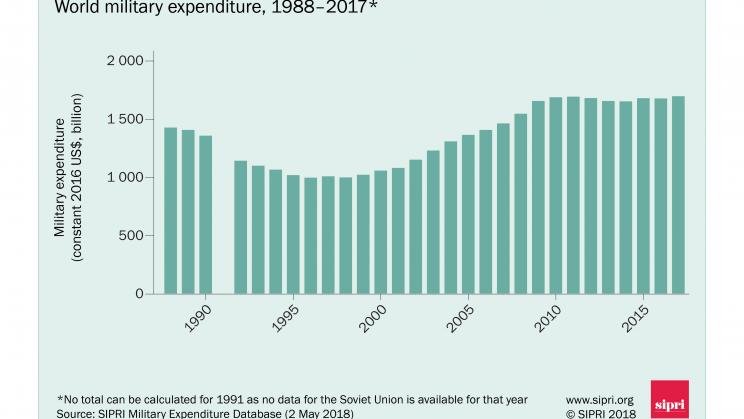
Total world military expenditure rose to $1.73 trillion in 2017, a marginal increase of 1.1 per cent from 2016. The 2017 expenditure is highest level since the Cold War, with the US, China and Saudi Arabia topping the list.
The Stockholm International Peace Research Institute (SIPRI) said that the spending translated into $230 per person.
But military expenditure in Africa decreased by 0.5 per cent in 2017, the third consecutive annual decrease since the peak in spending in 2014.
The US remained the world’s largest spender with $610 billion unchanged year-on-year.
The US accounted for over a third of global military expenditure.
“The downward trend in US military spending that started in 2010 has come to an end,” said Aude Fleurant, head of SIPRI’s arms and military expenditure programme.
Second-placed China was estimated to have spent 228 billion dollars, and according to SIPRI accounted for the largest absolute increase in spending – 12 billion dollars, measured in constant 2016 prices.
The research institute said it estimated that China’s share of global spending has doubled since 2008 to 13 per cent.
Saudi Arabia replaced Russia in third place, spending 69.4 billion dollars in 2017.
READ: Canadian PM Justin Trudeau questioned over efforts to reject asylum seekers
The Middle East was the region where military spending was estimated to account for the highest portion of GDP, just over five per cent, although SIPRI said data was sketchy from several countries including Syria, the United Arab Emirates, Qatar and Yemen.
“In spite of low oil prices, armed conflict and rivalries throughout the Middle East are driving the rise in military spending in the region,” said Pieter Wezeman, senior researcher with the SIPRI programme.
Seven countries in the Middle East were among the 10 countries with the highest share of military spending as a portion of GDP, including Oman with 12 per cent of GDP, and Saudi Arabia with 10 per cent of GDP.
Russia’s spending meanwhile dropped by one fifth in real terms compared to 2016 to 66.3 billion dollars.
It was the first drop since 1998. SIPRI attributed the drop to factors such as falling oil prices.
“Military modernization remains a priority in Russia,” Wezeman said.
India edged France to take fifth place, spending almost 64 billion dollars.
The combined spending of the top five military spenders accounted for 60 per cent of global military spending.
Europe accounted for one fifth of global military spending, but fell compared to 2016 and was only slightly higher than in 2008.
Four of the top 15 global military spenders were based in Europe: France, Britain, Germany and Italy.
Asia and Oceania’s share of global military spending was about one quarter, mainly fuelled by China’s expenditure.
Other top spenders in the region that were among the top 15 global spenders were India, Japan, South Korea and Australia.
The institute said Algeria remained Africa’s largest spender, but its spending dropped in 2017 due to lower
oil and gas prices.
In South America spending increased over 4 per cent, driven by Argentina and Brazil.
SIPRI said its figures include salaries, costs for operations, purchases of arms and equipment as well as research and development.










